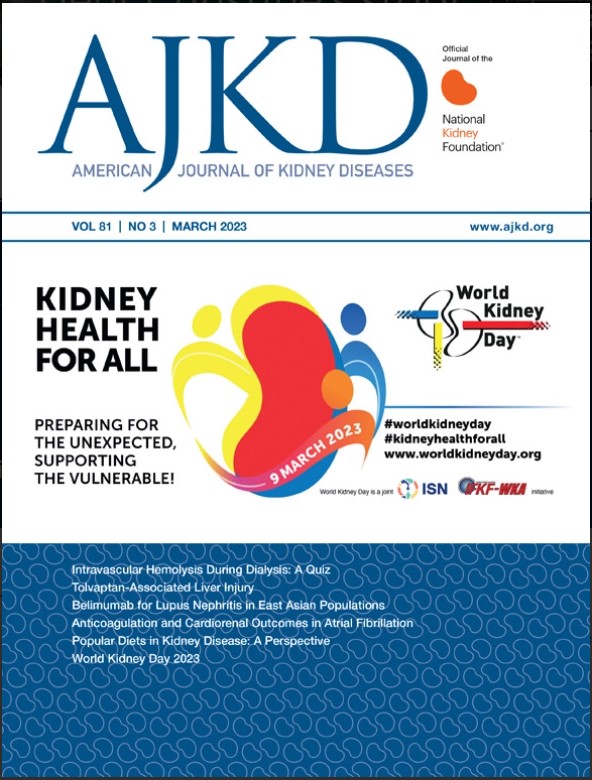Validation of an Algorithm to Identify End-Stage Kidney Disease in Electronic Health Records Data
IF 8.2
1区 医学
Q1 UROLOGY & NEPHROLOGY
引用次数: 0
Abstract
Rationale & Objectives
Accurate ascertainment of end-stage kidney disease (ESKD) in electronic health records (EHRs) data is important for much epidemiological research. This study developed and validated an algorithm using diagnosis and procedure codes to identify patients with ESKD (treated with maintenance dialysis or kidney transplantation) in EHR data.
Study Design
Study of diagnostic algorithms.
Setting & Participants
The development cohort included 559,615 patients treated at the Geisinger Health System (January 1996-June 2018). The validation cohort included 767,186 patients treated at New York University Langone Health System (January 2018 to December 2020).
Algorithms Compared
The algorithm used diagnosis and procedure codes compared with a nominal gold standard designation within the United States Renal Data System (USRDS) data. The performance of the algorithm was characterized by sensitivity, specificity, positive predictive value (PPV), and negative predictive value (NPV). The dates of incident ESKD between the algorithm and USRDS were compared in a subset of cases.
Outcome
ESKD (maintenance dialysis, prior recipient of a kidney transplant, or kidney transplantation surgery) cases.
Results
In Geisinger, we developed an ESKD algorithm that identified 4,766 (0.85%) ESKD cases; there were 5,155 (0.92%) ESKD cases reported by the USRDS. The sensitivity, specificity, PPV, and NPV of the algorithm were 73.9% (95% CI, 72.7-75.1%), 99.83% (99.82-99.84%), 79.9% (78.9-81.0%), and 99.76% (99.75-99.77%), respectively. When applying the algorithm to New York University Langone Health System data, the sensitivity, specificity, PPV, and NPV were 71.8% (95% CI, 70.7-73.0%), 99.95% (99.95-99.96%), 91.6% (90.8-92.4%), and 99.79 (99.78-99.80%), respectively. The median difference between dates of incident ESKD (algorithms minus USRDS) was −3 (IQR, −21 to 83) days for Geisinger and 0 (IQR, −12 to 69) days for New York University Langone Health.
Limitations
Use of structured EHRs data only.
Conclusions
Algorithms combining diagnosis and procedure codes show high specificity and modest sensitivity for identifying patients with ESKD, providing a research tool to inform future EHRs-based studies.
Plain-Language Summary
Although electronic health records (EHRs) data holds great promise for advancing kidney research, little work has been done to accurately identify ESKD cases in these data. This study developed and validated an algorithm using diagnosis and procedure codes to identify ESKD in EHRs. Our findings showed that the algorithm performed consistently in 2 different health systems, demonstrating high specificity and negative predictive values but lower sensitivity and positive predictive value. This algorithm may inform future ESKD research using EHR data.
在电子健康记录数据中识别终末期肾脏疾病的算法验证。
理由与目的在电子健康档案(EHRs)数据中准确确定终末期肾脏疾病(ESKD)对许多流行病学研究具有重要意义。本研究旨在开发和验证一种使用诊断和程序代码的算法,以识别电子病历数据中的ESKD患者(接受维持性透析或肾移植治疗)。研究设计:诊断算法研究。环境和参与者:发展队列包括559,615名在Geisinger卫生系统(1996年1月至2018年6月)接受治疗的患者。验证队列包括767,186名在纽约大学朗格尼卫生系统(2018年1月至2020年12月)接受治疗的患者。compare一种使用诊断和程序代码开发的算法,与美国肾脏数据系统(USRDS)数据中的名义金标准名称进行比较。该算法具有敏感性、特异性、阳性预测值(PPV)和阴性预测值(NPV)的特点。在一组病例中,比较了算法和USRDS之间的ESKD事件日期。结果:kd(维持性透析,既往肾移植接受者,或肾移植手术)病例。结果Geisinger开发的ESKD算法识别了4766例(0.85%)ESKD病例,而USRDS报告的ESKD病例为5155例(0.92%)。该算法的敏感性为73.9% (95% CI为72.7 ~ 75.1%),特异性为99.83% (99.82 ~ 99.84%),PPV为79.9% (78.9 ~ 81.0%),NPV为99.76%(99.75 ~ 99.77%)。将该算法应用于纽约大学朗格尼健康系统数据时,灵敏度、特异性、PPV和NPV分别为71.8% (95% CI, 70.7 ~ 73.0%)、99.95%(99.95 ~ 99.96%)、91.6%(90.8 ~ 92.4%)和99.79(99.78 ~ 99.80%)。事件ESKD(算法减去USRDS)日期之间的中位数(四分位数范围)差异在Geisinger为-3(-21至83)天,在纽约大学Langone健康中心为0(-12至69)天。限制:仅适用于结构化电子病历数据。结论结合诊断和程序代码的算法在识别ESKD患者方面具有高特异性和中等敏感性,为未来基于ehr的研究提供了一种研究工具。
本文章由计算机程序翻译,如有差异,请以英文原文为准。
求助全文
约1分钟内获得全文
求助全文
来源期刊

American Journal of Kidney Diseases
医学-泌尿学与肾脏学
CiteScore
20.40
自引率
2.30%
发文量
732
审稿时长
3-8 weeks
期刊介绍:
The American Journal of Kidney Diseases (AJKD), the National Kidney Foundation's official journal, is globally recognized for its leadership in clinical nephrology content. Monthly, AJKD publishes original investigations on kidney diseases, hypertension, dialysis therapies, and kidney transplantation. Rigorous peer-review, statistical scrutiny, and a structured format characterize the publication process. Each issue includes case reports unveiling new diseases and potential therapeutic strategies.
 求助内容:
求助内容: 应助结果提醒方式:
应助结果提醒方式:


